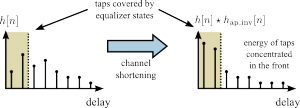Difference between revisions of "Channel Shortening Prefilter"
From iis-projects
| Line 1: | Line 1: | ||
| − | [[File: | + | [[File:ChannelShortening.png|thumb|A channel shortening prefilter concentrates the energy of the Channel Impulse Response (CIR) towards the first few taps.]] |
==Short Description== | ==Short Description== | ||
| − | + | In a wireless system with a multi-tap Channel Impulse Response (CIR) the receiver is confronted with a computationally challenging issue: Inter Symbol Interference (ISI) and Viterbi equalization. In particular as modern cellular standards tend to use ever higher modulation orders (up to 32-QAM) for Evolved EDGE, the equalizer becomes ever more complex. There exist various approaches to mitigate the induced ISI by a multi-tap CIR. The approach presented in [1] uses a channel shortening prefilter before equalization. Thus, ISI is mitigated to a large extent and the Viterbi equalizer's complexity is reduced. Said channel shortening prefilter has been thoroughly analyzed at the institute and a fix-point model has been built in MATLAB. In this project, the students ought to understand the channel shortening prefilter from [1] and implement it on an ASIC. The goal is to have an ultra-low power channel shortening prefilter. | |
===Status: Available === | ===Status: Available === | ||
| Line 10: | Line 10: | ||
: VLSI I | : VLSI I | ||
: MATLAB | : MATLAB | ||
| − | + | ||
| − | |||
| − | |||
| − | |||
| − | |||
| − | |||
| − | |||
| − | |||
| − | |||
| − | |||
===Character=== | ===Character=== | ||
: 20% Theory/Simulation | : 20% Theory/Simulation | ||
| Line 27: | Line 18: | ||
===Professor=== | ===Professor=== | ||
: [http://www.iis.ee.ethz.ch/portrait/staff/huang.en.html Qiuting Huang] | : [http://www.iis.ee.ethz.ch/portrait/staff/huang.en.html Qiuting Huang] | ||
| − | |||
==References== | ==References== | ||
| − | [1] Harald Kröll, Stefan Zwicky, Thomas Willi, Andreas Burg, Qiuting Huang. Optimal Channel Shortening and Equalization based on Information Rate Maximization for Enhanced 2G Networks. In ''TBD'', pages TBD, TBD. | + | [1] Fredrik Rusek, Adnan Prlja. Optimal Channel Shortening for MIMO and ISI Channels. In ''Wireless Communications, IEEE Transactions on'', vol. 11, no. 2, pages 810–818, 2012. |
| − | + | <!-- | |
| + | [2] Harald Kröll, Stefan Zwicky, Thomas Willi, Andreas Burg, Qiuting Huang. Optimal Channel Shortening and Equalization based on Information Rate Maximization for Enhanced 2G Networks. In ''TBD'', pages TBD, TBD. | ||
| + | ---> | ||
[[Category:Digital]] | [[Category:Digital]] | ||
[[Category:Available]] | [[Category:Available]] | ||
Revision as of 10:42, 24 March 2015
Contents
Short Description
In a wireless system with a multi-tap Channel Impulse Response (CIR) the receiver is confronted with a computationally challenging issue: Inter Symbol Interference (ISI) and Viterbi equalization. In particular as modern cellular standards tend to use ever higher modulation orders (up to 32-QAM) for Evolved EDGE, the equalizer becomes ever more complex. There exist various approaches to mitigate the induced ISI by a multi-tap CIR. The approach presented in [1] uses a channel shortening prefilter before equalization. Thus, ISI is mitigated to a large extent and the Viterbi equalizer's complexity is reduced. Said channel shortening prefilter has been thoroughly analyzed at the institute and a fix-point model has been built in MATLAB. In this project, the students ought to understand the channel shortening prefilter from [1] and implement it on an ASIC. The goal is to have an ultra-low power channel shortening prefilter.
Status: Available
- Looking for 1-2 Semester students
- Contact: Benjamin Weber
Prerequisites
- VLSI I
- MATLAB
Character
- 20% Theory/Simulation
- 50% VHDL
- 30% ASIC Implementation
Professor
References
[1] Fredrik Rusek, Adnan Prlja. Optimal Channel Shortening for MIMO and ISI Channels. In Wireless Communications, IEEE Transactions on, vol. 11, no. 2, pages 810–818, 2012.
